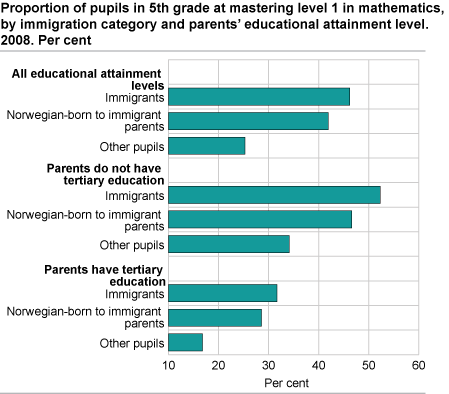Content
Published:
This is an archived release.
Social background has a great impact
Differences in pupils’ achievement in national tests are closely related to parents’ level of education, immigration background and municipal variations. Differences according to social background are significant in both 5t h and 8t h grade.
A close relation between pupils’ achievement in national tests and parents’ level of education is clear. Almost one out of three pupils in 5t h grade, whose parents have not attained tertiary level of education, scored at the lowest mastering level in all subjects (reading in Norwegian and English, and mathematics) in 2008. This proportion was between 14 and 18 percentage points higher compared with pupils whose parents have attained tertiary level of education. Among pupils at the highest mastering level an opposite ratio appears; a lower proportion of pupils whose parents have not attained tertiary level of education scored at the highest mastering level, compared with the pupils whose parents have a tertiary education. A similar trend is just as clear among pupils in 8th grade.
Differences in pupils’ achievement in national tests by parents’ level of education have changed very little from 2007 to 2008.
Immigrant pupils score poorer in national tests than other pupils
Immigrant pupils score weaker in all tested areas compared with Norwegian-born pupils to immigrant parents and other pupils. Comparing the two latter groups, there is not much difference in the results in English, but Norwegian-born pupils to immigrant parents achieve lower scores in reading Norwegian and mathematics.
Pupils in central municipalities and in large schools achieve the best results
Results from national tests show a clear coherence between achieved results in national tests and the centrality of pupils’ school municipality , in particular in 5t h grade.
In central municipalities, 25 per cent of the pupils in 5t h grade scored at the lowest mastering level in 2008. In the least central municipalities 31 per cent of the pupils scored at the lowest level. However, a larger proportion of pupils in central municipalities have parents who have attained tertiary education, compared with pupils in less central municipalities. Among pupils whose parents have not attained tertiary education, the difference in test results is reduced between central and less central municipalities.
In general, pupils attending large schools achieve better in national tests. In schools where there were more than 60 pupils in 5t h grade, 30 per cent of the pupils scored at the highest mastering level in mathematics in 2008. In schools where there were less than 11 pupils in 5t h grade, the corresponding proportion was 21 per cent. Differences between smaller and larger schools are also evident in reading in Norwegian and English.
Boys achieve higher scores than girls in mathematics
Girls scored better than boys in reading Norwegian in the national tests in 5t h and 8t h grade in 2007 as well as 2008. In mathematics the gender gap is reversed, with boys achieving higher scores than girls. In 8t h grade such gender differences in mathematics were found both in 2007 and 2008, whereas in 5t h grade they became more pronounced in 2008 than in the national tests in 2007. In reading English, only minor gender differences can be observed in the results from 2007 and 2008.
|
National tests in 5th and 8th grade have been conducted annually since 2007. The tests are carried out in the beginning of the school year (September), and reflect the competence objectives of the curriculum in 4t
h and 7t
h grade. Three tests are carried out in both 5t
h and 8t
h grade - reading in Norwegian, mathematics and reading in English.
The results presented are proportions at different assessment levels or mastering levels. More detailed information about the levels and boundaries between levels is available in about the statistics . |
Tables:
- Table 1 Distribution of pupils by mastering levels in national tests in 5th grade, by parents' educational attainment level and the centrality of pupils' school municipality. 2007-2008. Per cent
- Table 2 Distribution of pupils by mastering levels in national tests in 8th grade, by parents' educational attainment level and the centrality of pupils' school municipality. 2007-2008. Per cent
- Table 3 Distribution of pupils by mastering levels in national tests in 5th grade, by gender and parents' educational attainment level. 2007-2008. Per cent
- Table 4 Distribution of pupils by mastering levels in national tests in 8th grade, by gender and parents' educational attainment level. 2007-2008. Per cent
- Table 5 Distribution of pupils by mastering levels in national tests in 5th grade, by gender and immigration category. 2007-2008. Per cent
- Table 6 Distribution of pupils by mastering levels in national tests in 8th grade, by gender and immigration category. 2007-2008. Per cent
The statistics is now published as Marks and national tests, lower secondary school.


